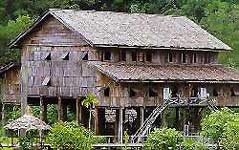Fort Margherita
 Constructed in 1878, it was recently renovated and converted into a palace museum. It is a building of love, named after the wife of the second White Rajah. The fort commands a breathtaking and strategic position along the Sarawak River. Its location was deliberately chosen to overlook the long straight stretch of river approaching Kuching. Now a palace museum, it houses a rare collection of Royal Regalia and historical paraphernalia.
Constructed in 1878, it was recently renovated and converted into a palace museum. It is a building of love, named after the wife of the second White Rajah. The fort commands a breathtaking and strategic position along the Sarawak River. Its location was deliberately chosen to overlook the long straight stretch of river approaching Kuching. Now a palace museum, it houses a rare collection of Royal Regalia and historical paraphernalia.
Luconia
 The South Luconia Shoals is one of the finest locations to dive. It is as good as the most pristine areas of the Great Barrier Reef. It is suitable for both the novice diver and the veteran with large areas of shallow flat reef, as well as drop-offs that have healthy corals to well below 120 feet. It also lies in the center of biodiversity for coral reefs, and as such contains hundreds of different tropical fishes and corals.
The South Luconia Shoals is one of the finest locations to dive. It is as good as the most pristine areas of the Great Barrier Reef. It is suitable for both the novice diver and the veteran with large areas of shallow flat reef, as well as drop-offs that have healthy corals to well below 120 feet. It also lies in the center of biodiversity for coral reefs, and as such contains hundreds of different tropical fishes and corals.
The Kuching Mosque
The Kuching Mosque is one of the city's most important landmarks, with its idyllic riverside location and its multiple gilded cupolas. Although a relatively modern building (1968), its design is faithful to traditional Islamic architecture. It is set in an ancient Muslim cemetery on the site of an old wooden mosque. The mosque and its grounds are open to visitors, but they are asked to dress respectfully and to not enter the mosque during prayer times. The Kuching Mosque previously functioned as the State Mosque but this role has now been taken over by the splendid new State Mosque across the river at Petra Jaya, which has an unusual modern single cupola design. Another interesting mosque can be found in Gambier Street. It is completely hidden away by rows of shophouses. This mosque originally served the Indian Muslim community in Kuching and is the oldest in the city.
Top of Page




 Unlike in a zoo, the Orang Utan (wild man of Borneo) at Semenggoh Rehabilitation Centre are set free in a 740 hectare forest reserve. Here, the Orang Utans and other native animals are nurtured to readapt themselves to the jungle life and to once again live in the wild. A half-hour leisurely stroll on the specially built plank-walks from the entrance of the Rehabilitation Centre gives you a golden opportunity to observe these orang utans, as well as view various species of trees and tropical fruit trees from the rainforest. It is sheer delight to watch these charming and entertaining Orang Utans during feeding time as well as their childlike antics.
Unlike in a zoo, the Orang Utan (wild man of Borneo) at Semenggoh Rehabilitation Centre are set free in a 740 hectare forest reserve. Here, the Orang Utans and other native animals are nurtured to readapt themselves to the jungle life and to once again live in the wild. A half-hour leisurely stroll on the specially built plank-walks from the entrance of the Rehabilitation Centre gives you a golden opportunity to observe these orang utans, as well as view various species of trees and tropical fruit trees from the rainforest. It is sheer delight to watch these charming and entertaining Orang Utans during feeding time as well as their childlike antics. On a 17 acre site at the foothill of Mount Santubong, fronting the South China Sea is the Sarawak Cultural Village, which exudes the typical warmth and hospitality of the state. Here, you have the opportunity to share the arts and crafts, games, food, and music of the seven major cultures of Sarawak. At a modern theater, the visitor can see performances of multicultural dances and lots of bamboo (bamboo musical instruments, bamboo carvings and even a bamboo bridge). You are taken into the world of "longhouses", drums, and gongs. You are taught to use the blowpipe (the weapon of the jungle nomads) and you get the opportunity to see the women work on their intricate beadwork.
On a 17 acre site at the foothill of Mount Santubong, fronting the South China Sea is the Sarawak Cultural Village, which exudes the typical warmth and hospitality of the state. Here, you have the opportunity to share the arts and crafts, games, food, and music of the seven major cultures of Sarawak. At a modern theater, the visitor can see performances of multicultural dances and lots of bamboo (bamboo musical instruments, bamboo carvings and even a bamboo bridge). You are taken into the world of "longhouses", drums, and gongs. You are taught to use the blowpipe (the weapon of the jungle nomads) and you get the opportunity to see the women work on their intricate beadwork.

